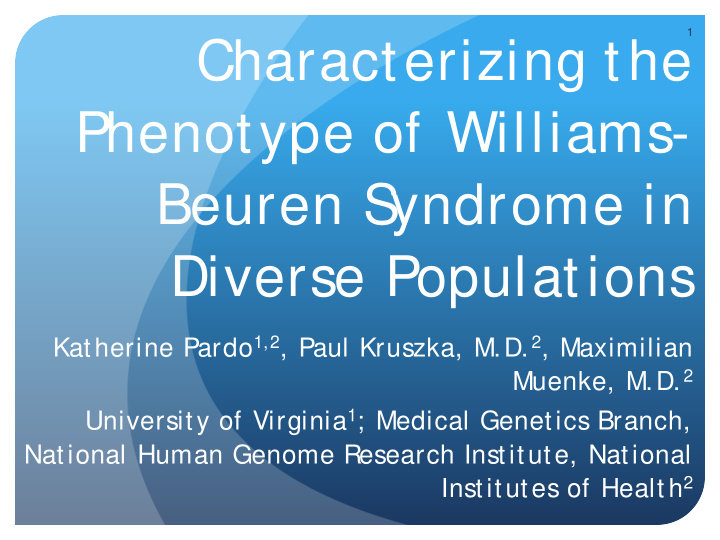



1 Characterizing the Phenotype of Williams- Beuren S yndrome in Diverse Populations Katherine Pardo 1,2 , Paul Kruszka, M.D. 2 , Maximilian Muenke, M.D. 2 University of Virginia 1 ; Medical Genetics Branch, National Human Genome Research Institute, National Institutes of Health 2
2 Atlas of Human Malformation Syndromes in Diverse Populations Response to many non-Caucasian populations having limited access to geneticists and are underrepresented in medical and genetic research. Addressing the notion that discrepancies in racial and ethnic background have posed a widespread challenge to phenotypic diagnosis. Will contain photographs and molecular diagnoses of individuals from diverse geographic locations. Will serve as a tool for clinicians in diagnosing syndromic disorders by promoting the association of congenital malformations with syndromes.
3 Obj ective To characterize the phenotype of Williams-Beuren S yndrome in underrepresented non-Caucasian populations in order to enhance the ability to clinically diagnose Williams-Beuren S yndrome across diverse populations.
4 Introduction • Williams-Beuren S yndrome: a multisystem disorder resulting from a chromosomal abnormality. Often determined to be de novo 1. and occasionally hereditary Dist inct ive facies Intellectual disability S upravalvular aortic stenosis Pulmonary arterial stenoses Hypercalcemia Dental malformation Unusually outgoing and trusting personality Figure 1. Chinese female with 1. Yau EK, Lo IF, Lam ST. Williams-Beuren syndrome in the Hong Kong Chinese positive clinical diagnosis. population: retrospective study. Hong Kong Med J. 2004 Feb;10(1):22-7. PubMed PMID: 14967851.
5 Procedure and Methods 41 patients have been clinically diagnosed with Williams-Beuren S yndrome and characterized by specific facial and gestalt phenotype. Facial Dysmorphology Novel Analysis, (FNDA) analysis using Face2Gene Technology served as exploratory tool for future diagnostic uses and an obj ective facial characterization instrument.
6 Facial Dysmorphology Novel Analysis, (FDNA): Face2Gene 1. 1. Yau EK, Lo IF, Lam ST. Williams-Beuren syndrome in the Hong Kong Chinese population: retrospective study. Hong Kong Med J. 2004 Feb;10(1):22-7. PubMed PMID: 14967851.
7 Face2Gene Face2Gene uses Bayesian net works t o assess t he probabilit y of having a syndrome. Gestalt: heat maps display the most distinguishable facial regions Red: strong similarity to a syndrome Blue: absence of similarity to a syndrome Feature: facial proportions are obtained and compared against a continually developing database.
8 Results • Underrepresentation of medical literature on individuals from diverse populations.
Results 9
10 Results S ensitivity= Number of True Positives X 100 _______________________________________________________________________________________________________ Number of True Positives + False Negatives
11 Discussion Williams-Beuren S yndrome lacks definition in underprivileged non-Caucasian populations due to the small amount of reported cases. The distinct ive facies characterizing Williams- Beuren S yndrome in Caucasians are consistent with found in non-Caucasian individuals. Face2Gene should only be used to support diagnostic confirmation only and should not be used as a primary diagnostic method.
12 Conclusion Williams-Beuren S yndrome in individuals from diverse populations is under-represent ed in the medical literature. The considerable precision of FDNA analysis using Face2Gene technology and its efficient improvement mechanism is indicative of its potential as a valuable resource to clinicians. This research will potentially enhance the quality and accuracy of diagnosing Williams-Beuren S yndrome in individuals.
13 Future Directions • Charact erizing Williams-Beuren S yndrome in diverse populat ions from Asia, S ub-S aharan Africa, Lat in American, and t he Middle East . • Adding a cont rol sample consist ing of individuals wit h syndromic diagnoses not including Williams-Beuren S yndrome t o furt her st at ist ical analysis. • Quant ifying observer variat ion t hrough blind t est ing of unrelat ed clinicians. • Test ing t he accuracy and precision of FDNA analysis using Face2Gene t echnology on individuals wit h a wide variet y of syndromes.
14 Acknowledgements Many t hanks go t o t he generous donors t o t he College S cience S cholars program who make t hese summer research awards possible: Charles Henry Leach, II, Foundat ion, Mr. S t eve Van Besien; Ent igence Corporat ion; Lois A. Fit t on & W. Christ opher Draper, Jr.; S haron B. Parent e & John W. Risner; The Jefferson Trust ; Robert At kinson; Lowe Family; Dean’s discret ionary gift s. I sincerely t hank Dr. Muenke and Dr. Kruszka for providing me wit h t he life-changing opport unit y of researching at t he Nat ional Inst it ut es of Healt h, and Professor S chmidt , Professor Epst ein, and Professor Demas for providing me wit h t he inspiring scient ific foundat ion t hat got me t here.
15 Questions?
Recommend
More recommend